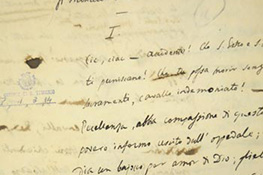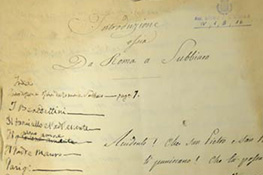Versione italiana English version Version française Versión en español
The archive of the Carrone di San Tommaso family was acquired by the historical library "Giuseppe Grosso" in 1959. It includes documents relating to Alexander (who died only 37 years in 1816), his wife Henrietta Guasco di Bisio, and Felix their son. The family, of Savoyard origin, moved to Piedmont in 1649, in the person of Marquis Giovanni in the retinue of Carlo Emanuele II of Savoy.
The most notable figure is Felice (Florence 1810 - Turin 1843), elected mayor of Sommariva Perno in 1839, scholar and writer. Having studied paleography under the guidance of Luigi Cibrario, he used to transcribe documents of his interest, papers that we find in the archive. Felice published a work that is still valid today because it was conceived with modern historiographical criteria, the Genealogical Tables of the Royal House of Savoia. As for his literary commitment, the Cosiderations around the Farsaglia by Marco Anneo Lucano, published in Turin in 1837, had great success. He was also the author of various travel articles, short stories and short stories, all published in a comprehensive collection entitled Prose scelte , published in Milan in 1840.
Among the unpublished works by Felice, the most important and demanding is Il Monaco di Subbiaco, that is the memory of an Italian gentleman: a sketch of a novel of which the plot and the division into chapters is outlined, left incomplete by the author's death. The work, characterized by more realism and more immediacy in the dialogues than the previous ones, talk about a young scholar whom in the company of friends travels from Rome to Subiaco in the autumn of 1832. Here he visited with his companions the monastery of Santa Scolastica where Father Placido told them about his life. By consulting the documents of the archive, the autobiographical character of the work clearly emerges, in fact, remarkable affinities stand out between the events narrated and those relating to the life of the Marquis Felice.
Among the manuscripts are poetic, historical, dramatic and the curious "black" story L'épouse vampire. Count of a voyageur traduit de l'englais par un ermite de la place de St. Charles à Turin. In short, a vintage Twilight, dated around 1840 and therefore even preceding the famous Dracula by Bram Stoker.
The notes used by the Marquis Felice for the writing of his historical and literary works are also preserved, among which stands out the dossier entitled Voyage en Italie in which the Marquis narrates a journey made to Italy with very interesting observations.
As for the correspondence kept between the family cards, we find a large number of letters of the Marquis Felice, largely intended for his mother, but also those addressed to him by well-known characters of the time, such as Cibrario, Moscow, Cesare Saluzzo, Litta, Romans, with whom Felix corresponded. A rich correspondence also involves Enrichetta Guasco di Bisio, the Marquise in fact held in Turin a salon frequented by famous writers and artists, so we find among the correspondents Cibrario, Giordani, Promis, Marocchetti and many others.
The archive also consists of numerous documents relating to the family; the oldest is the act of 2nd March 1644 by which Christina of France Duchess of Savoy sells for the sum of 25 thousand silver shields the fief of Sommariva Perno to Guglielmo Francesco Carron of San Tommaso. The papers of the Marquis Alessandro date back in most of the Napoleonic era: among these an autograph of Napoleon himself.
The archive is completed by various documents concerning Favria, the fief owned by the Carrone di San Tommaso: the oldest dates back to 1733. Finally copies of bubbles, treatises and various protocols.
- Archive inventory (pdf 669 KB)
The inventory is based on the archiving done by Giuseppe Aldo di Ricaldone, writer, archivist and paleographer.


